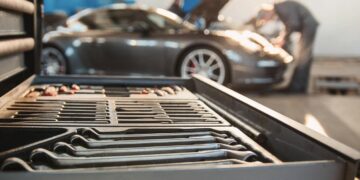
Basic concepts
Flow: The amount of water that circulates through our route per unit of time (Flow Rate in English) and is measured in liters per hour.
Pressure: It is the force of water. This parameter is inversely proportional to the flow. It is measured in meters
Restriction: It is the phenomenon that occurs when any component of our system causes a decrease in the flow or pressure of our circuit, which usually causes a loss of performance.
Tips to consider
1. The only thing that really cools is the radiator and it usually doesn’t get the attention it deserves. Radiators, the greater the dissipation area, the better: The worst of double radiators is usually better than the best of single radiators.
2. We always have to think that our limit is about 5 – 10 degrees above the ambient temperature (delta).
3. What increases the performance is the flow (amount of water). The pressure only helps that if we have to refrigerate several components in series, we have enough flow at the outlet of a block
4. If I want to know a temperature I cannot be guided by what the motherboard tells me, I have to put a probe.
5. Actually having a leak is “dangerous”: It does not mean that it is normal to have it or that we will automatically burn the computer … you just have to be careful.
Choice of components
Bomb
There are two types of pumps: boat pumps, small ones that operate at 12v and are based on pressure. There are also the typical aquarium pumps, which operate at 220v, and these have a balanced flow and pressure, usually more flow than pressure.
The pumps are classified and measured with, in addition to the noise they generate (measured in dB), consumption, pressure and flow. Flow is the measure of the amount of liquid that a pump can move without restriction. Usually measured in liters per hour.
Head pressure is the force or height at which a pump can push the liquid at full load (with a flow restriction of 0 or 100%). It is measured by looking at the height at which a pump can push water through a thin tube and is usually measured in feet or meters. A pump with a high flow rate is useless if it cannot push the water through minor restrictions. Similarly, a pump with high head pressure and low flow is also not very useful.
Radiator
There are two radiator systems. One, formed by a zigagueante tube, which is measured in tube length and in the number of passes, that is, the times the radiator travels.
The other type is flat tube radiators, which are less restrictive and more efficient than those of the other type.
Also, some radiators are thicker than others. This, combined with the density of the fins, determines what is the ideal type of fan you want to use on the radiator. The thickness is measured in mm and it comes in all kinds of measurements, the thickest I have seen is 80mm and about 20mm for the thinnest. Density is measured in fins per inch.
Thicker, denser radiators need fans with high static pressure to push air through the fins. Thinner radiators with lower fin density work best with fans that have a lot of air flow.
As a general rule, a minimum 120mm radiator is recommended for each GPU and CPU water block in your system. If we are going to have a system with two blocks, it is advisable to have at least a double radiator (240mm or 280mm). Also keep in mind to always choose a copper radiator to prevent the blocks from corroding with the aluminum.
Deposit
Depositing in a good RL is essential, since we will make sure that our circuit has no air and thus avoid loss of performance due to two factors: air contact with copper (worst conductor), and the malfunction of the bomb caused by the existence of air inside. The most efficient tanks are the long tube tanks, while the bay tanks have more purging problems.
Blocks
Blocks of water are used to transfer heat from the source to the water. They are heat exchangers that move heat energy into the water from the heat generating component. Blocks of water depend on surface and flow to transfer heat quickly and efficiently. Like radiators, the more surface area there is, the more heat can be transferred.
There are several types of blocks. The Jet system that is drilled under pressure, through small tubes that make the shower effect. These types of blocks are very restrictive, which makes it almost unfeasible to mount a circuit with more than one block of this type
The microchannel system, also restrictive blocks although less than these. Its surface is formed by several small walls alternated with small grooves, giving rise to microchannels. There are also the classic designs, which we can find from two main models.
The block constraint is the metric that is used to compare blocks. This is a measure of the amount of water that can be pumped through the block in a given time. High restriction blocks often work best with a more powerful pump. Low restriction blocks tend to have lower performance, but allow more blocks to be put together.
Tubes and fittings
A minimum internal diameter of 10 mm (3/8 inches) or 13 mm (1/2 inch) is recommended. There are few situations where the 13mm (1 / 2in) ID hose exceeds 10mm (3/8 inch) temperature, so we recommend this option based primarily on the one that seems best to you.
You must take into account that all the components you choose must have the same diameter, both external and internal, so that we can adjust all the components correctly.
There are different tubes (Tygon, clearflex) although the most common one that we usually find in stores is the vinyl one, which we should avoid since it does not have as much flexibility as the others.
Coolant
Normally you should use distilled water mixed with 10% antifreeze, never again because it would lose heat transfer, and if you want, some additive. There are also ready-made additives that ensure better performance but are more expensive, this is already a matter of taste. If it’s hard to choose best CPU cooler for i9 9900k so you can gather all the necessary information and make a decision which will be helpful for you in future.
Planning and assembly
This is an important part of the process and you have to plan the whole circuit before you start: determine the order of the components, where you plan to mount each radiator, tank and pump, how you are going to mount the fans and determine the length of each section of pipe.
There are different forms of assembly, although the most common is the American, which is what we usually find in commercial kits.
· German style: it is characterized by using medium flow pumps, low pressure, and slightly restrictive components.
· Generally this system is mounted as follows: Pump -> Radiator -> CPU Block -> GPU Block -> Deposit -> Pump
· American estimate: it is characterized by high flow and more pressure, with much wider tubes (at least 12mm). It can be mounted in the same way as the German one or it can be added to the end of the circuit.
· Australian style: It is an evolution of the American style in which even more restrictive blocks are used.
· The way to mount it is usually this: Pump -> CPU Block -> GPU Block -> Radiator -> Tank -> Pump
Cleaning and maintenance
The first thing you want to do when you have all the components before starting it, preferably with distilled water. It is also interesting to add water before the coolant and run it for at least half an hour to clean all the components before running it.
As maintenance, it is convenient to change the coolant a couple of times a year, emptying and cleaning the entire circuit with distilled water and vinegar for at least an hour. In this way we will avoid that algae are produced and the circuit becomes dirty.
























































